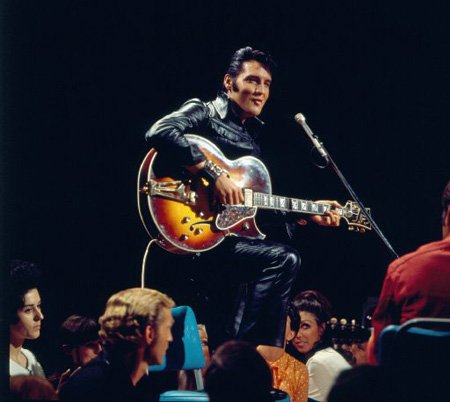Not a disciple of The King? Visit Graceland. You will leave a believer.
At least 600,000 people a year still believe in the dreamer, the small-town boy made good, the legend that was Elvis Presley. Like pilgrims drawn to Mecca, they come to Graceland, the mansion in Memphis where Elvis lived and died, to remember and to pay their respects.
From all over the world — the United Kingdom, France, Japan, Spain and Germany — the fans come, because they wonder what it would have been like to walk a mile in those blue suede shoes — to be rich, to be famous, to be handsome and talented and adored — and they imagine what rock ’n’ roll might have become if its architect hadn’t died at the age of 42.
The Elvis portrayed at Graceland may not be the whole story. But Graceland reminds even the unconverted that Elvis was an amazing talent who changed the face of music forever — 14 Grammy nominations, three wins and a Lifetime Achievement Award, 149 singles, albums or EPs
that went gold, platinum or multiplatinum, 1 billion records sold worldwide.
Elvis was truly a king.
Graceland
Ticket in hand, visitors can board a shuttle bus for the short ride across Elvis Presley Boulevard from the museum and gift shop complex to a 1939 Southern Colonial mansion. Elvis bought Graceland in 1957 — when he was just 22 years old — paying $100,000 for the 14-acre estate. On the taped Graceland tour, Elvis tells listeners that his happiest times were spent with his family there, and daughter Lisa Marie adds that “Graceland was always very alive” and says her father “definitely permeated the space.”
The mansion’s upper floor isn’t open to the public — hasn’t been since Graceland became a tourist attraction in 1982 — and it’s easy to imagine that perhaps Elvis really is still alive, just keeping to himself while other people enjoy the home he redecorated shortly before his death in 1977. His presence is still that pervasive: There’s a baby grand piano waiting for him, just on the other side of the stained glass windows at the far end of the all-white living room; pool balls racked and ready to go on the pool table in the fabric-lined game room; all three televisions still on in the yellow and blue TV room downstairs.
However, the wood-paneled kitchen, Lisa Marie says on the tour tape, was “Grand Central” for the house, which was busy 24 hours a day. The TV was always on there too, she says, and someone was always cook- ing — always the Southern-style food that Elvis and his compan- ions enjoyed most.
Beyond the kitchen, Elvis created a family room that became infamous: The Jungle Room. Decorated in 1974, it features a custom-designed waterfall, lots of heavy, carved- wood furniture upholstered in fake fur, green shag carpet on the floor and ceiling and lots of statues of monkeys and big cats. It looks, in its own unique way, homey and comfortable, just like the rest of Graceland.
Presley wasn’t trying to be ostentatious; apparently, he just liked what was hot in the 1970s, whether that meant an all-black dining room or a white fur, clam-shaped bed. Money let him collect and create; his status as a legend preserves what he enjoyed, a time capsule of times gone by.
The Dream Dies
On the grounds of Graceland, after tourists have visited the “Trophy Building,” where Pres- ley’s honors have been collected, and on the far side of the swim- ming pool where Elvis played with his friends, the last tour stop is a “Meditation Garden,” built in 1965.
There, in 1977, the King of
Rock ’n’ Roll joined his mother, already buried there, and his father followed in 1979. Three decades later, the graves are covered with flowers, flags, stuffed hound dogs and teddy bears brought and sent by fans who have not forgotten.
Elvis, says a newspaper head- line posted at Graceland, “came, he sang and he conquered.” At his grave, it’s easy to forget any preconceptions and just mourn the loss of a legend.
Sun Studio
Two other Memphis land- marks are integral parts of the Elvis Presley story — Sun Studio and Lauderdale Courts.
It was 1953 when Elvis Pres- ley, just 18 years old, walked in to Sun Studio — then known as the Memphis Recording Service — and was turned away when
his demo song didn’t impress Sun founder Sam Phillips.
But Presley continued to hang around, and in 1954, Phil- lips asked him to sing again. The song was “That’s Alright, Mama” — and the rest is history.
At Sun Studio today, visitors can touch Presley’s first micro- phone and more.
“Experience the stories that put legends like Johnny Cash, Carl Perkins, Jerry Lee Lewis and more on the map, and see why artists like U2, Tom Petty and Maroon Five continue to flock here today,” its Web site promises.
Sun Studio, at 706 Union Ave., is open 10 a.m. to 6 p.m. daily, and there is free shuttle service from Graceland. Admission is $12. Information: 800-441-6249.
Lauderdale Courts
Before Graceland, Elvis — with his parents — lived in Lauder- dale Courts, 185 Winchester, Apartment 328, from September 1949 to January 1953.
Scheduled for the wrecking ball in the mid-1990s, Presley’s teenage home was saved by the efforts of Elvis fans, Memphis Heritage preservation organiza- tion, the City of Memphis and Memphis developers Jack Belz and Henry Turley.
Now part of the Uptown Square apartment community, Apartment 328 — “the Elvis Suite” — rents for $249.99 a night. Information: 901-523-8662 or www.lauderdalecourts.com.

